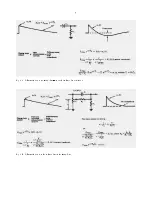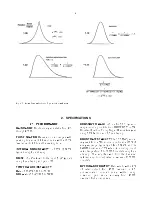
7
direct connection. When any one of these units is
used, it should be terminated with a 100Ω
terminator at the amplifier input or be used with at
least one of the output attenuators set at In. (The
small error due to the finite input impedance of the
amplifier can normally be neglected.)
SPECIAL CONSIDERATIONS FOR POLE-ZERO
CANCELLATION
When a tail pulser is connected
directly to the amplifier input, the PZ Adj should be
adjusted if overload tests are to be made (other
tests are not affected). SeeSection4.6forthe pole-
zero adjustment. If a preamplifier is used and a tail
pulser is connected to the preamplifier test input,
similar precautions are necessary. In this case the
effect of the pulser decay must be removed; i.e., a
step input should be simulated.
3.5. SHAPING CONSIDERATIONS
The shaping time constant on the 572A is switch-
selectable in steps of 0.5, 1, 2, 3, 6, and 10 µs. The
choice of the proper shaping time constant is
generally a compromise between operating at a
shorter time constant for accommodation of high
counting rates and operating with a longer time
constant for a better signal-to-noise ratio. For
scintillationcounterstheenergyresolutiondepends
largely on the scintillator and photomultiplier, and
therefore a shaping time constant of about four
times the decay-time constant of the scintillator is a
reasonable choice (for Nal, a 1-µs shaping time
constant is about optimum). For gas proportional
counters the collection time is normally in the 0.5 to
5 µs range and a 2 µs or greater time constant
selectionwillgenerallygiveoptimumresolution.For
surface barrier semiconductor detectors, a 0.5 to 2
µs resolving time will generally provide optimum
resolution. Shaping time for Ge(Li) detectors will
vary from 1 to 6 µs, depending on the size,
configuration, and collection time of the specific
detectorandpreamplifier.Whenacharge-sensitive
preamplifier is used, the optimum shaping time
constant to minimize the noise of a system can be
determined by measuring the output noise of the
systemand dividing it by the system gain.Sincethe
572A has almost constant gain for all shaping
modes,theoptimumshapingcanbedeterminedby
measuring the output noise of the 572A with a
voltmeter as each shaping time constant is
selected.
The 572A provides both unipolar and bipolar
outputs. The unipolar outputpulsesshould be used
in applications where the best signal-to-noise ratio
(resolution) is most important, such as high-
resolution spectroscopy using semiconductor
detectors. Use of the unipolar output with baseline
restorationwillalsogiveexcellentresolutionathigh
counting rates. The bipolar output should be used
in high count rate systems when the analyzer
system is ac-coupled and noise, or resolution, is a
secondary consideration.
3.6. LINEAR OUTPUT CONNECTIONS
AND TERMINATING CONSIDERATIONS
Since the 572A unipolar output is normally used for
spectroscopy the 572A is designed with a great
amount of flexibility in order for the pulse to be
interfaced with an analyzer. A gated baseline
restorer (BLR) circuit is included in this output for
improved performance at all count rates. A switch
on the front panel permits the threshold for the
restorer gate to be determined automatically,
according to the input noise level, or manually, with
a screwdriver adjustment. The switch also has a
center PZ Adj setting that can be used to eliminate
theBLReffectwhenmakingpole-zeroadjustments.
The unipolar output dc level can be adjusted from
-0.1 to +0.1 V to set the zero intercept on the
analyzer when direct coupling is used. The bipolar
output, with a 0 to 10 V range, can be used for
crossover timing or may be preferred for
spectroscopy when operating into ac-coupled
systems at high counting rates. Typical system
block diagrams for a variety of experiments are
described in Section 4.
Three general methods of termination are used.
The simplest of these is shunt termination at the
receiving end of the cable. A second method is
series termination at the sending end. The third is
a combination of series and shunt termination,
where the cable impedance is matched both in
series at the sending end and in shunt at the
receiving end. The combination is most effective,
but this reduces the amount of signal strength at
the receiving end to 50% of that which is available
in the sending instrument.
To use shunt termination at the receiving end of the
cable, connect the <1Ω output of the 572A (on the
front panel) through 93Ω cable to the. input of the
receiving instrument. Then use a BNC tee
connector to attach both the interconnecting cable
and a 100Ω terminator at the input connector of the
Содержание 572A
Страница 6: ...vi...
Страница 24: ...18 Fig 4 16 Gamma Ray Charged Particle Coincidence Experiment Fig 4 17 Gamma Ray Pair Spectrometry...
Страница 26: ...20 Fig 5 1 Amplifier Block Diagram...














































